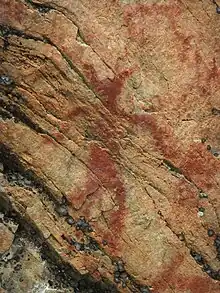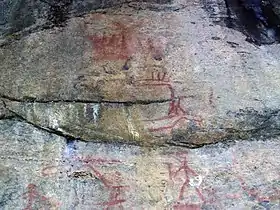Finnish rock art
Finnish rock art pictographs created during the Stone Age have been found at 127 sites around Finland. They consist mainly of brownish-red figures and markings painted onto steep granite walls, often overlooking waterways. There are scenes featuring people, boats, elk, fish and mysterious part human figures. The survival of the art in adverse climatic conditions is due to their protection by a naturally forming thin layer of silicon dioxide on the rock surface.[1]


The Comb Ceramic Culture who lived in what is now Finland between 5000 BC and 2000 BC is credited with their production. The paints used included a mix of iron oxide, blood, and animal fat or egg, although traces of the organic materials are no longer detectable. Characteristic to the art are sacrificial parts (arrow points, bones, signs of fire, etc.) and the location on steep cliffs at water’s edge. Similar sites can be found in parts of Northern Sweden, Norway and Russia – mainly, it seems, in areas once populated by the Saami or other Finnic peoples.[1]
The first paintings to be recognised as Stone Age were reported in 1911 by Jean Sibelius, whose eye was caught by strange patterns on a lakeside cliff near Hvitträsk, the home of his friend, architect Eliel Saarinen.
More paintings were discovered in the 1960s a few miles west of Hvitträsk at Juusjärvi. At first they were thought to be recent graffiti daubed by power line workers, but they were soon ascertained to be several thousand years old.
Most of the paintings lie in the Saimaa and Päijänne lake districts.[1] By far the best-known site, at Astuvansalmi, has been proposed as a UNESCO World Heritage Site.[2] Another site is Värikallio in the Hossa Hiking Area. This has unusual figures with triangular heads.[3][4] The biggest painted area is in Central Finland, where the Saraakallio rock paintings includes 50–200 pictures, maybe even more.[5][1]
Gallery
 Astuvansalmi rock paintings (moose, human figures and a boat)
Astuvansalmi rock paintings (moose, human figures and a boat) Saraakallio rock paintings (moose)
Saraakallio rock paintings (moose)
See also
References
- "A Touch of Red : Archaeological and Ethnographic Approaches to Interpreting Finnish Rock Paintings" (PDF). The Finnish Antiquarian Society. 2008. pp. 9, 24, 132. Retrieved 22 Feb 2014.(in English)
- "The Rock paintings of Astuvansalmi at Ristiina". UNESCO World Heritage Center. Retrieved 13 January 2013.(in English)
- Taskinen, Helena. "The Värikallio rock painting, Suomussalmi" (PDF). Rock Art in Northern Europe (RANE). Archived from the original (PDF) on 24 July 2007. Retrieved 13 January 2013.
- Weaver, Fran (2008) Rock Art From 5,000 Years Ago, Helsinki Times, 31 March (in English)
- Kivikäs, Pekka (1990). Saraakallio – Muinaiset kuvat (in Finnish). Jyväskylä: Atena Kustannus. p. 9. ISBN 951-9362-24-X.
External links
- Finnish Rock Art Association (in Finnish)
- Scandinavian Society for Prehistoric Art Archived 2013-02-28 at the Wayback Machine
- A map indicating rock art places in Finland Published by Association of Finnish Prehistoric Art. (in Finnish)
- Rock Art Paintings in Finland Bradshaw Foundation Online Rock Art Archive.